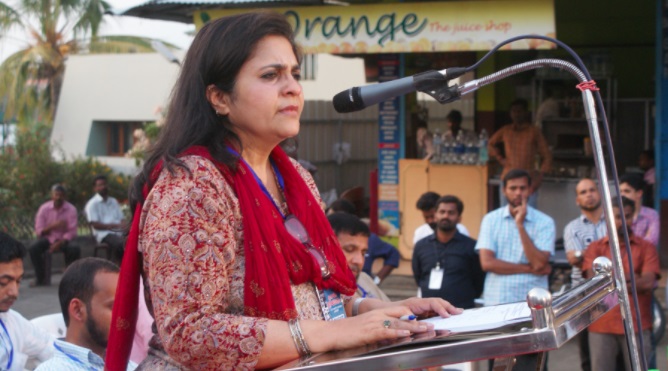
The twelfth edition of the Festival del Cinema dei Diritti Umani di Napoli or a film festival of Human Rights began in Naples in Italy on November 17. Filmmakers, activists and intellectuals from Italy and all over the world came together to discuss challenges to democracy and human rights in wake of the Covid-19 pandemic. One would recall that Italy was one of the worst hit at the beginning of the pandemic and now India is struggling with the infection that is spreading rapidly.
As a part of the film festival an online discussion was organised which saw two Indian stalwarts; author Arundhuti Roy and journalist and human rights defender Teesta Setalvad, showcase the aftermath of the pandemic vis-à-vis its impact on democracy, human rights and particularly the lives and livelihood of socio-economically marginalised communities and religious minorities.
Arundhuti Roy in fact drew parallels between the nationwide lockdown in wake of the Covid-19 pandemic and the unplanned demonetisation disaster of the ruling regime from November 2016. Roy had written about it in a recent piece for the Financial Times.
“In India, the minute that it is announced that the Prime Minister will address the nation, it is always terrifying,” said Roy who had written the following about the Indian Prime Minister in her Financial Times piece: “His methods definitely give the impression that India’s prime minister thinks of citizens as a hostile force that needs to be ambushed, taken by surprise, but never trusted.”
Taking on from where Roy left off, Setalvad reminded everyone of the regime’s clampdown on dissenting voices with the help of their stooges in the media. “The fact that Arundhuti Roy till a certain point in history could write in any of India’s top publications, but now has to write in the Financial Times, itself tells you a story. The media is a big part of the abdication within India over the last six and a half years,” said Setalvad adding, “The media, particularly the electronic media is not talking about wider democratic concerns. Most of the media has become virtually a propaganda tool for this establishment.”
Setalvad then explained the growing gap between that ‘haves’ and ‘have-nots’ in India saying, “The social, economic and political inequality within Indian democracy has got so sharpened. In 2000 we had 9 billionaires. In 2018, we had 119 billionaires. 83 percent of our representatives in Parliament are billionaires.” Explaining how they exercise their influence, she said, “Today these billionaires represent mining companies, TV companies and telecom companies.”
She further asked, “There is a stranglehold on Indian democracy. Who speaks, what do you speak about? Do you speak about unemployment, do you speak about 650 million migrant workers? We became aware of their plight during the pandemic, but were they visible to the state, politicians and activists before that?”
Setalvad further referred to lynchings as well as amendments to citizenship laws as a wider ideological project that was at work even before the pandemic. Setalvad also explained how the National Register of Citizens (NRC) in Assam was a part of this agenda, but eventually ended up affecting not only Muslim minorities, but also other marginalized communities including Bengali Hindus and indigenous communities such as Gorkhas.
“Just before the pandemic hit, there were creative and peaceful protests across the country where people denounced the CAA,” she said referring to the Citizenship Amendment Act. “Shaheen Bagh was an inspiring example of a protest led by Muslim women staking their claim to being counted as Indians. It was not a sectarian protest, it was a protest claiming their rights as citizens,” said Setalvad.
“It appeared for sometime that the authoritarian government did not know what to do. They were taken aback,” said Setalvad adding, “For two and a half months the protests revived hopes of standing up to the regime and then came the lockdown.” Explaining the genesis of the migrant crisis Setalvad said that the government did not release the over 90 million tonnes worth of foodgrains to help alleviate hunger of economically weak sections during the pandemic. “Fearing the prospect of starvation, the migrants started walking back to their villages. 10 million migrants took trains but had to borrow money to buy tickets because the government refused to give them welfare support,” she said.
“The real story after the pandemic has been that of hunger, hatred and collapse of institutions like the judiciary and the election commission,” said Setalvad.
The entire online discussion may be viewed here:
https://www.facebook.com/
Related: